Picture this: You’re stuck in Manila traffic in the middle of a June downpour, Grab surge is skyrocketing, and your phone battery blinks 4 %. — right when you need that QR code for the MRT. You rummage through your bag, fish out a mystery power bank you bought on a flash sale, and… nada. One port is dead, the other trickles power slower than the traffic on EDSA. That “never again” moment is why you’re here, scanning spec sheets like a detective.
Let’s decode those specs—mAh, wattage, ports—so the next time you buy a power bank, you know exactly what you’re getting and why it matters.

Editor
Lloyd Kelly Miralles chevron_right
Table of Contents
Capacity: mAh vs. Watt-Hours (Wh)
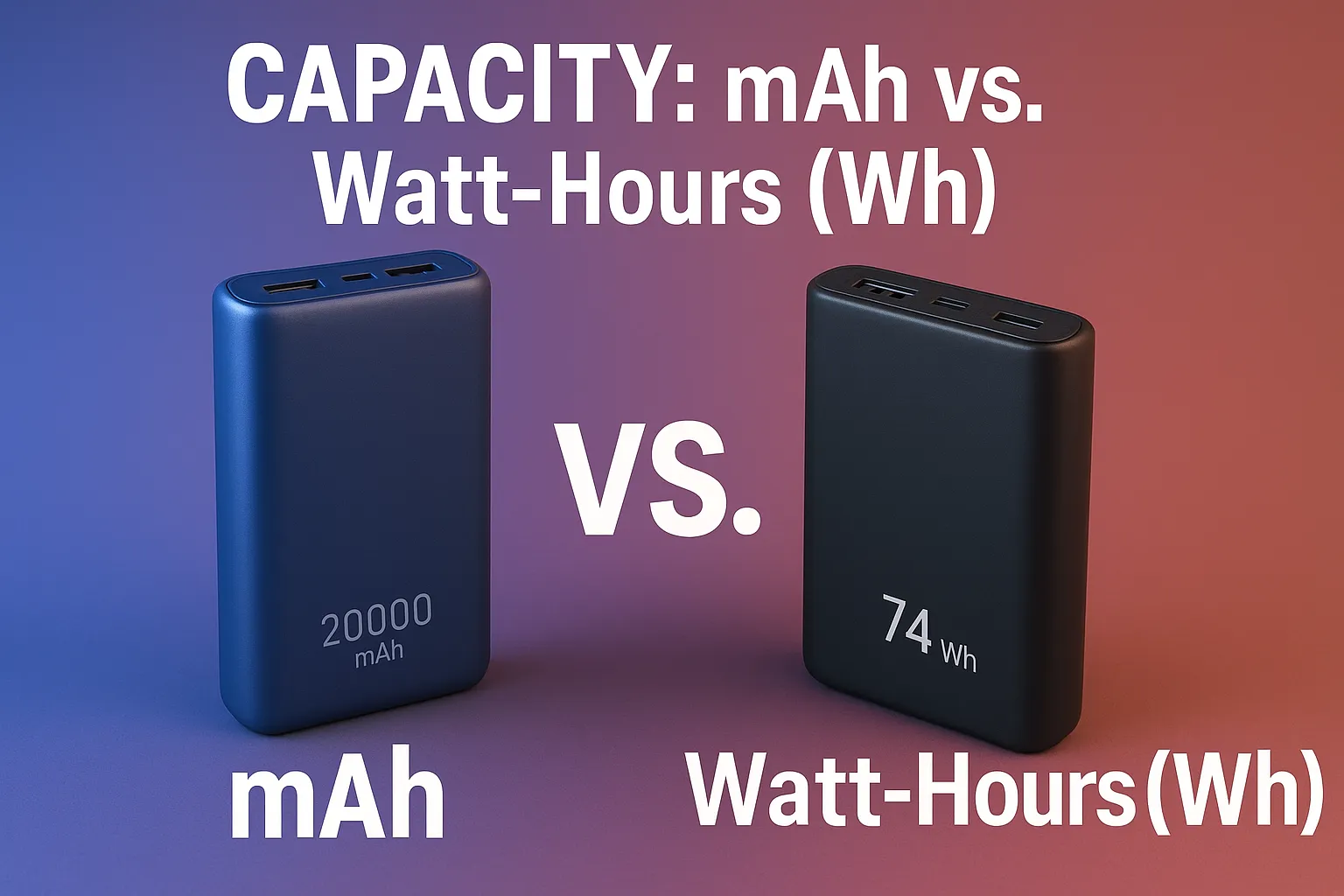
When you flip a power-bank box over, the first number that jumps out is usually mAh—“milliamp-hours.”
Think of it like counting how many cups of water fit inside a jug. More cups (higher mAh) = a bigger jug.
But here’s the catch: every device “drinks” at a different water pressure (voltage).
So the industry also uses watt-hours (Wh) to describe how much energy is really stored, no matter the pressure.
1-Minute Analogy
|
Water Story |
Battery Reality |
|
Cups of water (mAh) — volume in the jug |
Charge stored in the cells |
|
Water pressure (Volts) — garden sprayer vs. fire hose |
Output voltage (5 V phone charge, up to 20 V laptop PD) |
|
Total splashing power (Wh) — cups × pressure |
The true, apples-to-apples energy figure |
Shortcut: The “Divide by 27” Rule
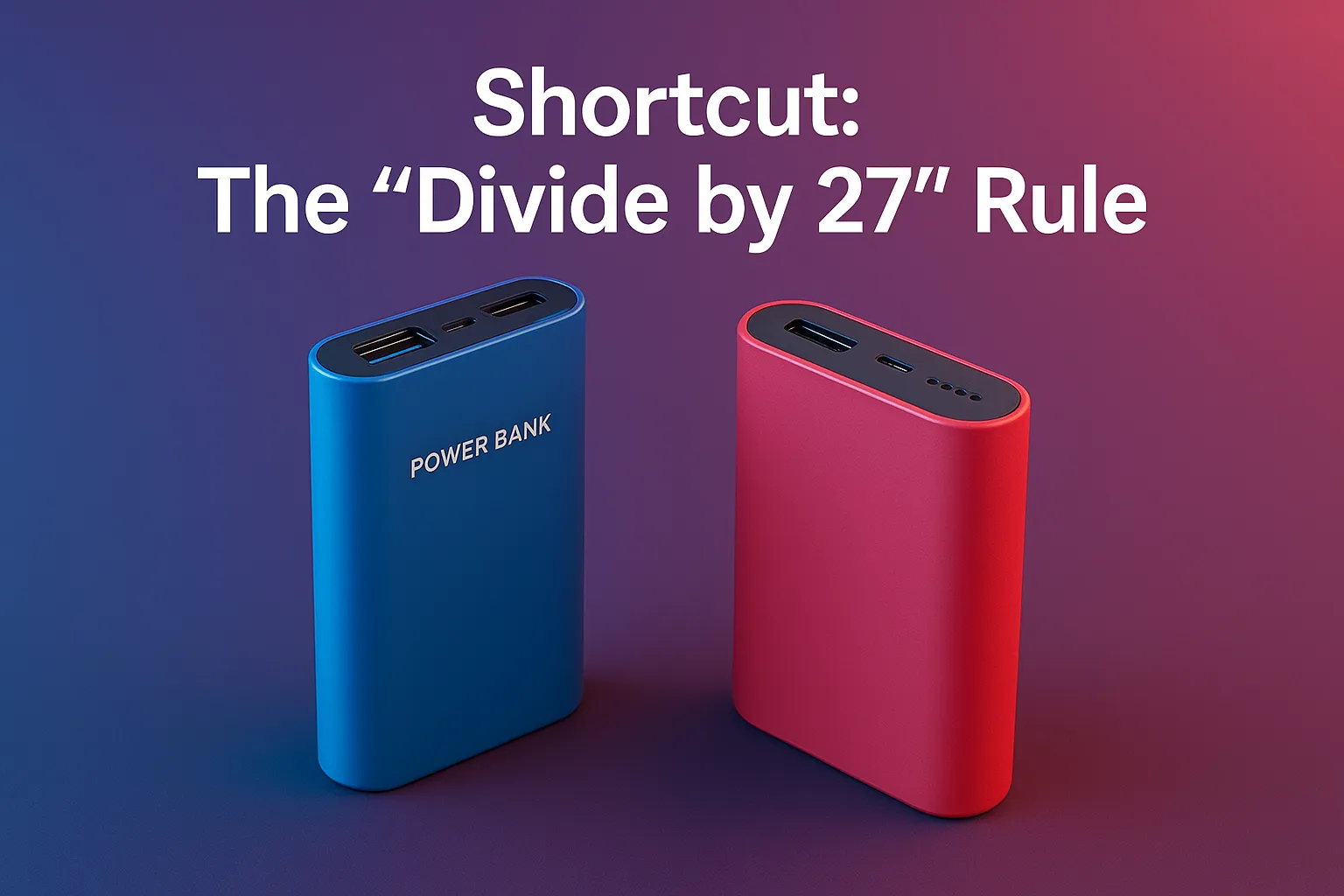
Most modern power banks use 3.7 V lithium cells inside. To jump from mAh to the airline-friendly Wh number:
mAh ÷ 27 ≈ Wh
- 10 000 mAh ➜ ~37 Wh
- 20 000 mAh ➜ ~74 Wh
- 27,000 mAh ➜ ~100 Wh (airline maximum you can hand-carry with zero paperwork)
No calculator? Just remember, “twenty thousand is roughly seventy-four.” Good enough for check-in counters.
So, How Many Phone Charges Is That, Really?
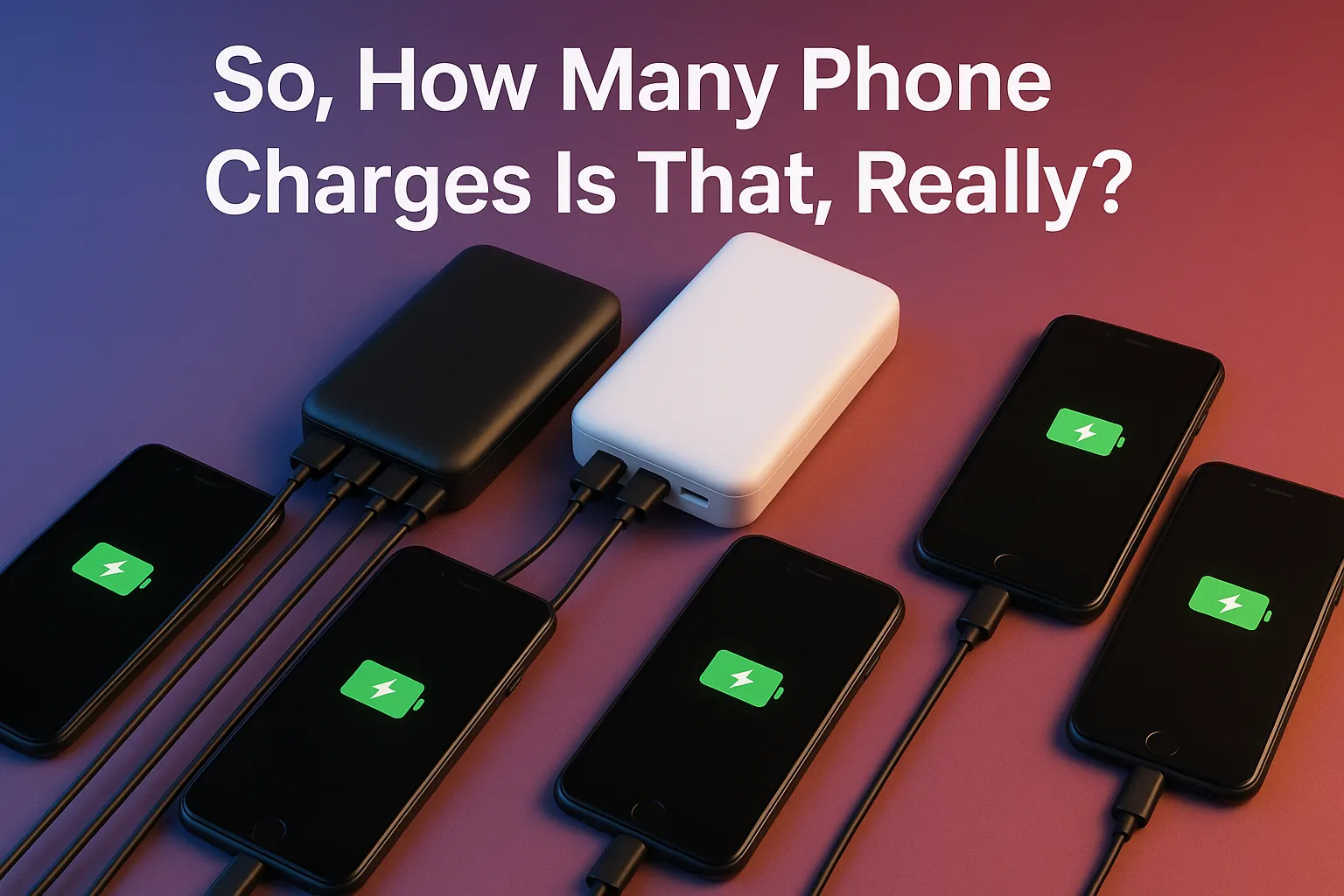
- Start with Wh. (Our example: 20,000 mAh ≈ 74 Wh.)
- Expect 25 % energy loss during voltage conversion and heat.
- Usable energy = 74 Wh × 0.75 ≈ 55 Wh.
- Find your phone’s battery in Wh.
- A 5,000 mAh phone at 3.85 V ≈ , 19 Wh.
- Divide.
- 55 Wh ÷ 19 Wh ≈ 2 ¾ full charges.
If marketing claims “5× charges,” now you know why real-world numbers feel smaller—physics pockets the change.
Quick Capacity Cheat Table
|
Printed Size |
Airline Status |
Rough Real-World Phone Charges* |
|
10,000 mAh (~37 Wh) |
Always allowed |
1 – 1.5 |
|
20,000 mAh (~74 Wh) |
Always allowed |
2.5 – 3 |
|
26 800 mAh (~99 Wh) |
Top limit for carefree travel |
3.5 – 4 |
|
30,000 mAh (~111 Wh) |
Airline approval needed |
4–5 (but paperwork!) |
*Based on a 5 000 mAh smartphone and 25 % conversion loss.
The Take-Home
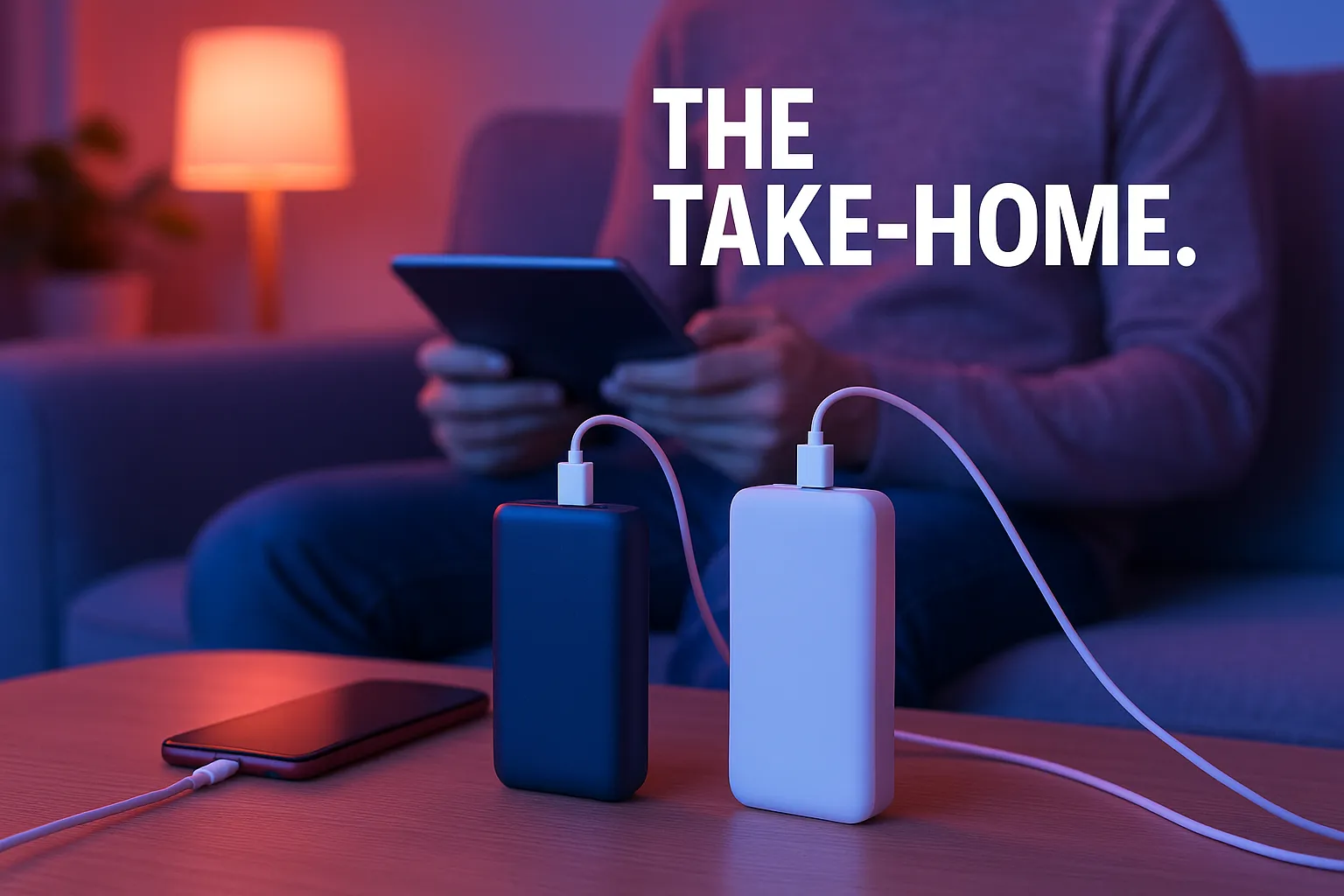
- mAh is the jug size; Wh is the water plus pressure—use Wh for apples-to-apples and airline gates.
- Bigger mAh doesn’t always mean more usable juice if output voltage (and losses) climb.
- For quick mental math, divide mAh by 27 to check flight rules, then divide usable Wh by your device’s Wh to spot honest charge counts.
Master that, and you’ll never stare at a dead phone—and a useless mystery brick—on a rain-soaked commute again.
Output Power: Watts and Fast-Charging Labels
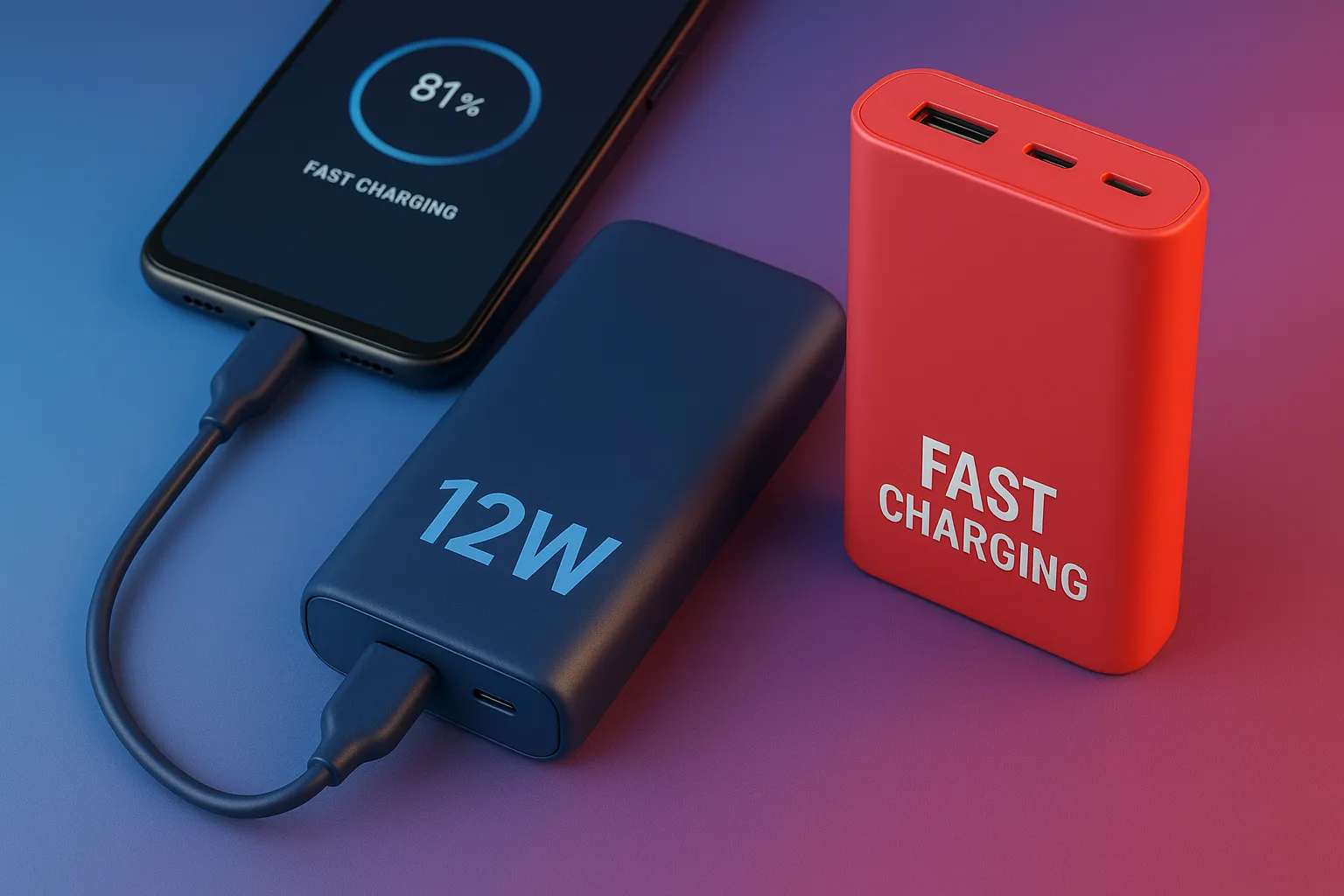
Ever notice two power banks with the same capacity but one refills a laptop while the other can’t even wake an iPad? That’s the wattage talking.
Decoding the jargon
|
Label on the Box |
What It Really Means |
Where You’ll Feel It |
|
18 W QC 3.0 |
Quick Charge 3.0, peaks at 12 V × 1.5 A |
Fast for older Android phones |
|
30 W USB-C PD |
Power Delivery up to 20 V × 1.5 A |
Tablets, Switch, mid-range laptops |
|
65 W PD/PPS |
Programmable Power Supply, adaptive 5-21 V |
Ultrabooks, Steam Deck |
|
100 W PD 3.0 |
Full-size laptop territory |
13–14″ MacBook Pro, Dell XPS |
|
140 W PD 3.1 |
Latest high-power spec (28 V × 5 A) |
16″ MacBook Pro, USB-C gaming rigs |
Heads-up: The port and the cable must support the listed wattage. For 100 W and above, look for an e-marker chip inside the USB-C cable sleeve.
Ports & Their Personalities
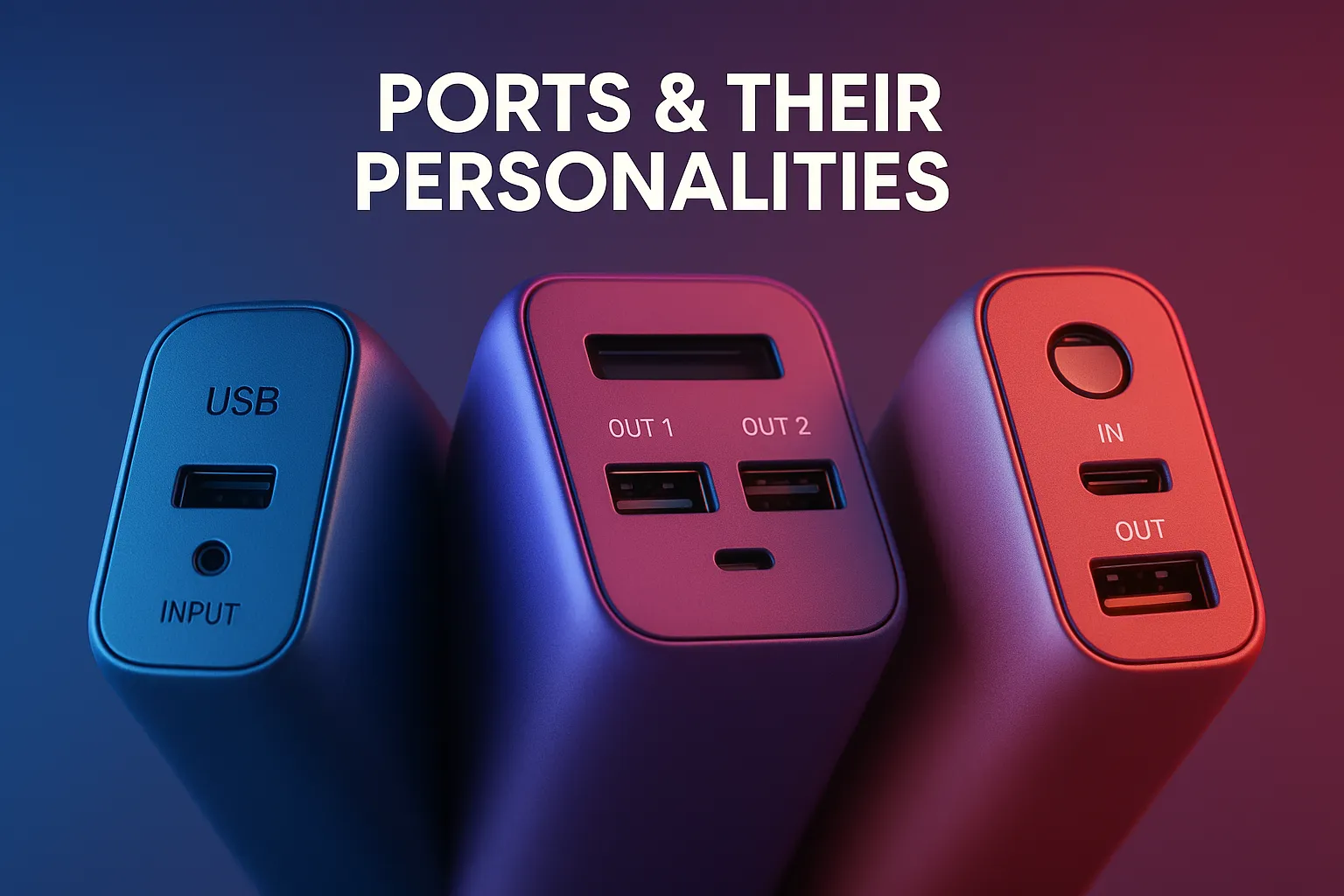
Only one sentence of packaging can hide a jungle of nitty-gritty. Use the bullets as a cheat sheet:
- USB-A (legacy)
- Tops out at 18–22 W with Quick Charge 3.0.
- Great for earbuds, older phones.
- Tops out at 18–22 W with Quick Charge 3.0.
- USB-C In/Out
The Swiss Army knife of 2025. Supports PD, PPS, even laptop-level 140 W with the right silicon. -
- Recharges the power bank itself far faster than micro-USB ever could.
- Recharges the power bank itself far faster than micro-USB ever could.
- Multiple USB-C ports
- Look for shared vs. per-port power. One 140 W headline may split into 100 W + 40 W when two devices plug in—fine for a MacBook + phone combo.
- Look for shared vs. per-port power. One 140 W headline may split into 100 W + 40 W when two devices plug in—fine for a MacBook + phone combo.
- Pass-Through Charging
- Lets you charge the bank and your phone simultaneously—ideal for limited wall outlets in cafés. Check if the feature throttles speed.
- Lets you charge the bank and your phone simultaneously—ideal for limited wall outlets in cafés. Check if the feature throttles speed.
- Display vs. LED Dots
- A wattage readout (e.g., “45 W OUT”) beats four vague blinking lights, especially if you juggle cameras, tablets, and a laptop.
- A wattage readout (e.g., “45 W OUT”) beats four vague blinking lights, especially if you juggle cameras, tablets, and a laptop.
- AC or DC barrel jack
- Niche but useful for DSLRs or routers during typhoons. Confirm voltage matches your gear.
- Niche but useful for DSLRs or routers during typhoons. Confirm voltage matches your gear.
Real-World Math: How Many Phone Charges?
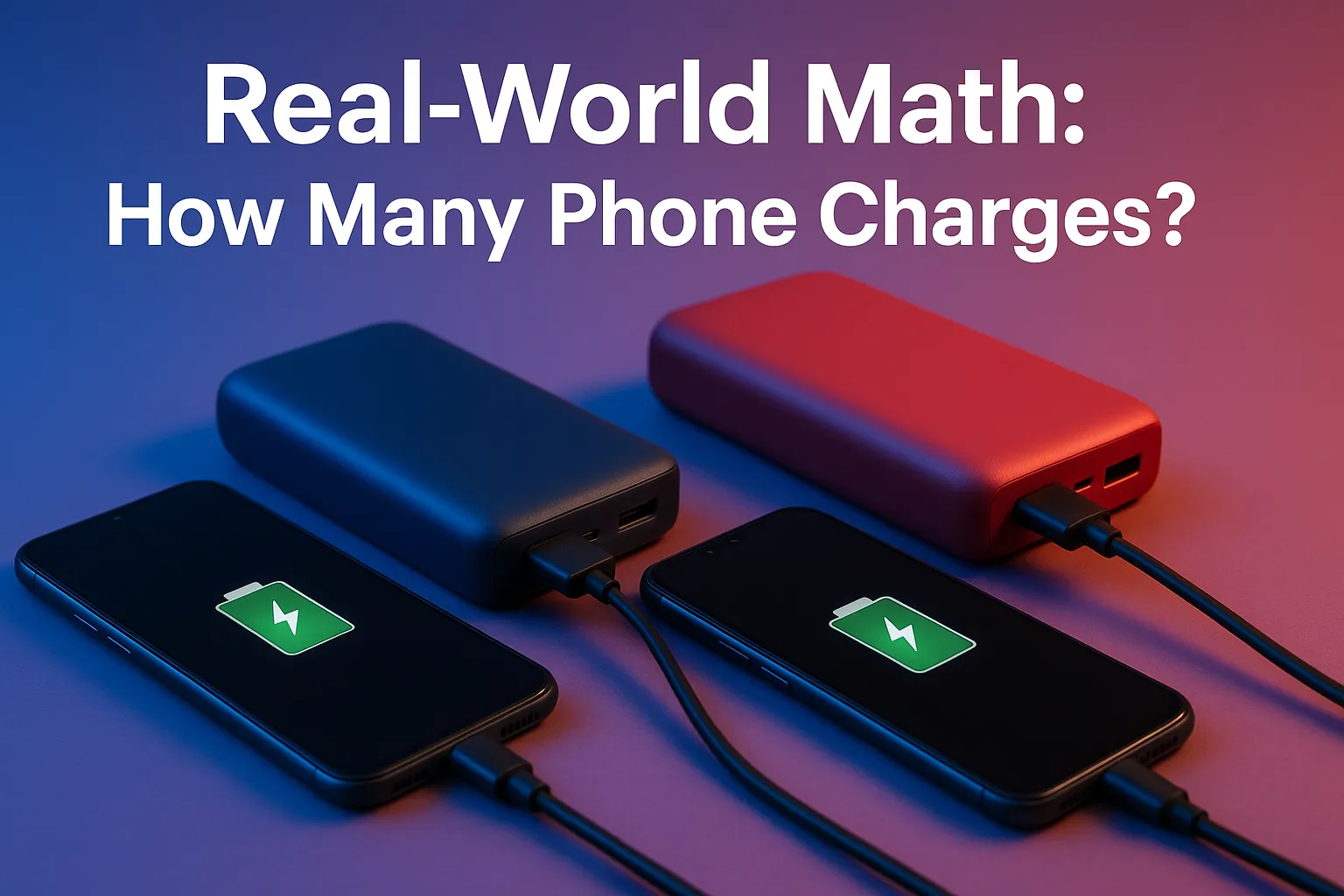
Say you have a 24,000 mAh (≈ 89 Wh) power bank and a phone with a 4,000 mAh battery.
- Account for conversion loss—about 25 %.
- Usable energy: 89 Wh × 0.75 ≈ 67 Wh.
- Phone needs: 4 Ah × 3.85 V ≈ 15.4 Wh.
- Result: 67 Wh ÷ 15.4 Wh ≈ 4.3 full charges.
Marketing might shout “6×,” but physics keeps the receipt.
Safety & Airline Rules (2025 Snapshot)
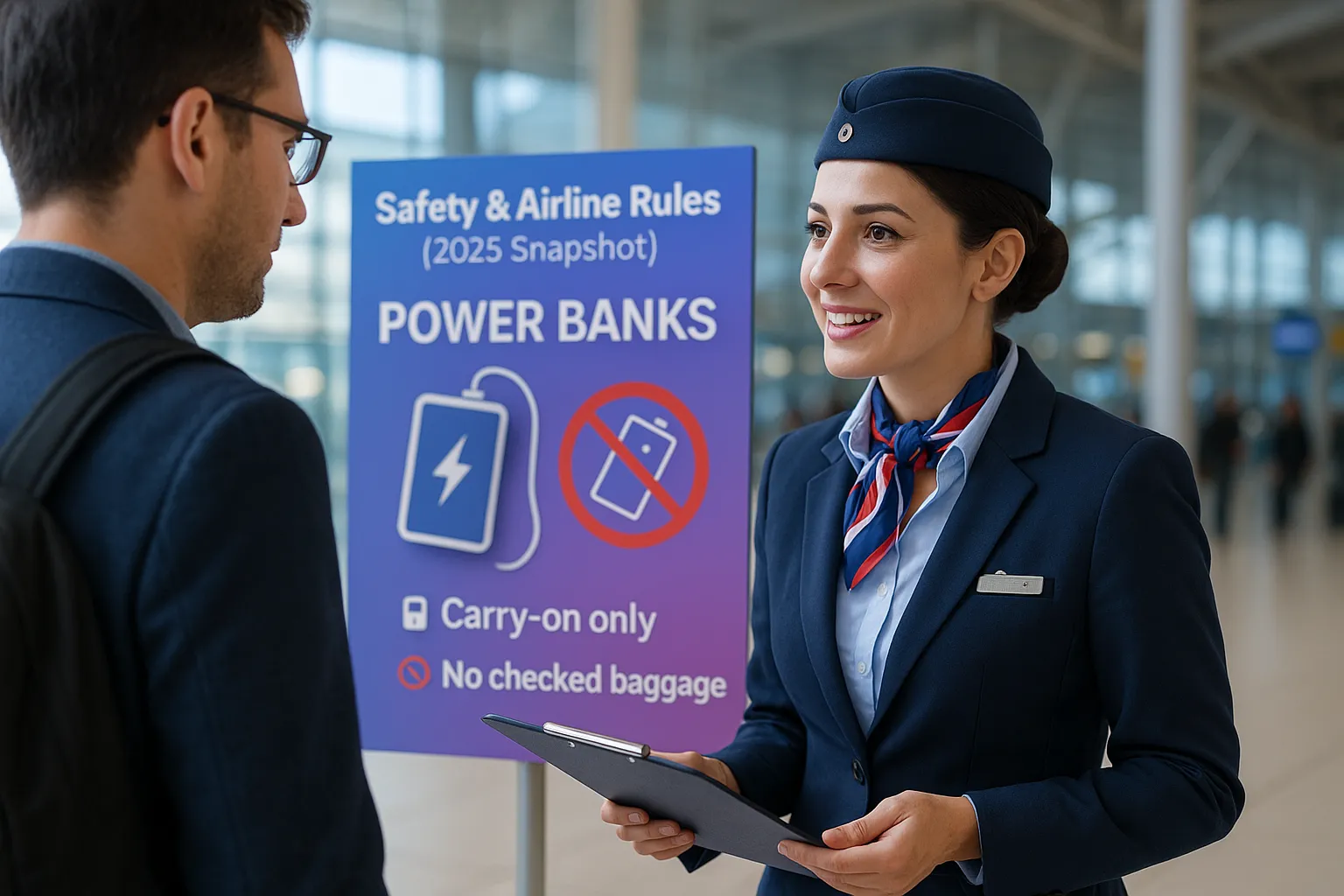
- Under 100 Wh: Free pass in carry-on bags.
- 100–160 Wh: Two units max, airline approval needed.
- 160 Wh+ : Hard no—ship it cargo or leave it home.
- In-flight use bans: Some carriers now ban using (not carrying) power banks after a mid-air fire scare. Check advisories before boarding.
Always keep the capacity label visible; screeners may confiscate “mystery” bricks.
Buying Checklist (Bookmark-Worthy)
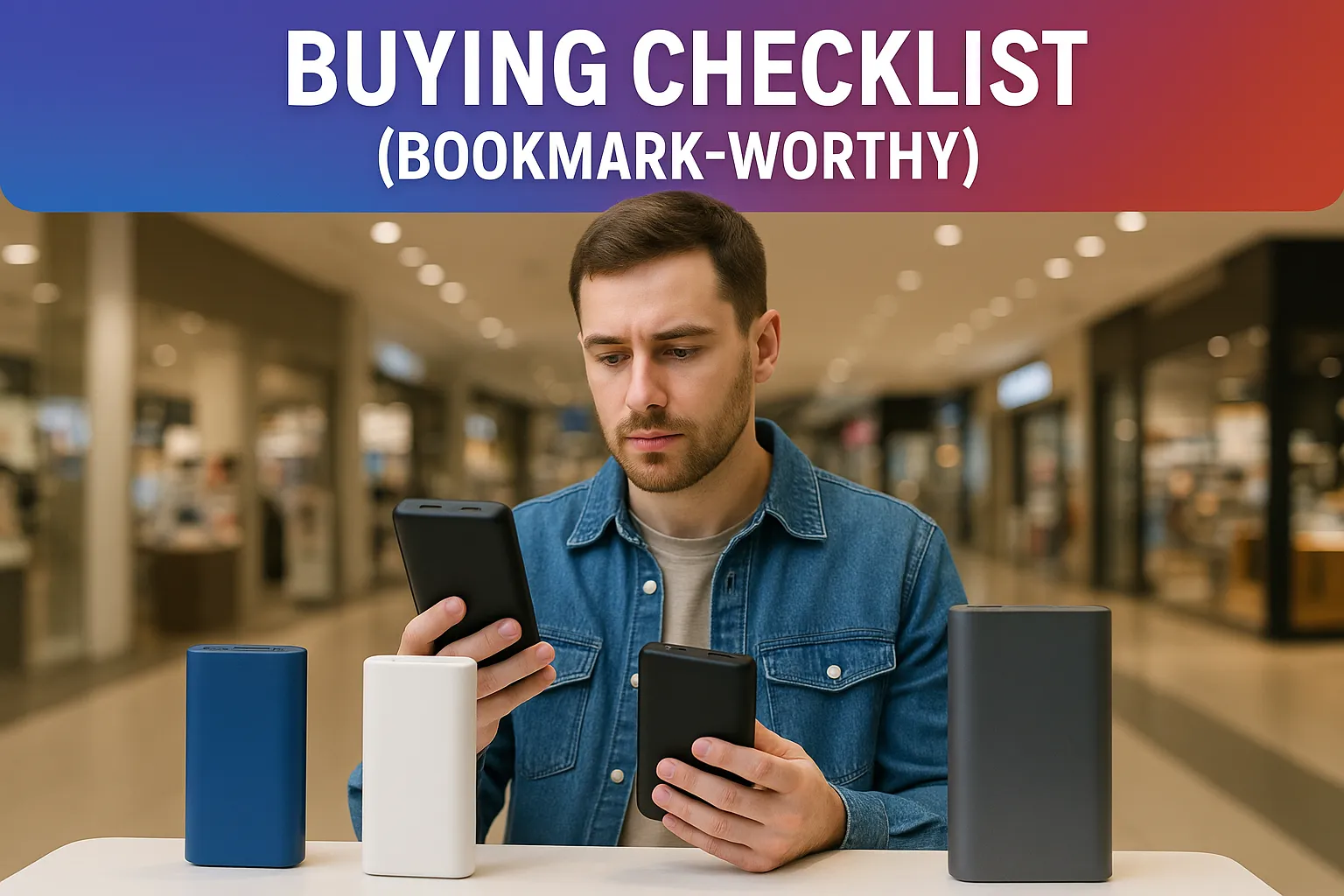
- Capacity in mAh and Wh clearly printed
- USB-C PD port with enough watts for your largest device
- Verified cable rating (60 W vs. 100 W vs. 240 W)
- Built-in safeguards: over-voltage, over-temperature, short-circuit
- Airline-compliant < 100 Wh if you travel frequently
- Clear digital readout or at least percentages, not just blinking lights
- Reputable brand with replaceable cable, accessible warranty center in PH.
Conclusion
mAh tells you how long a power bank can run, wattage tells you how fast, and ports dictate what you can actually charge. To see these features in action, check out our Best Power Banks in the Philippines guide. Match all three to your lifestyle—whether that’s reviving a dying phone on a rain-blocked jeepney route or juicing a 16-inch laptop during a café hopping workday—and you’ll never stare at a dead device again.
